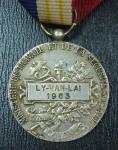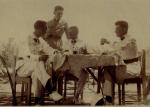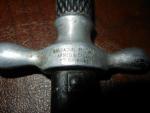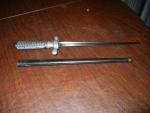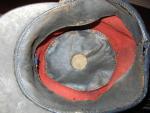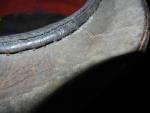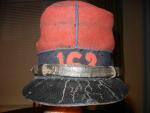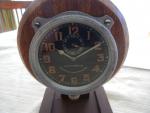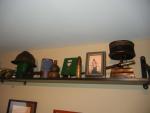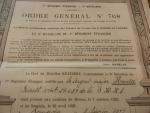-
Posts
267 -
Joined
-
Last visited
-
Days Won
1
Content Type
Profiles
Forums
Blogs
Gallery
Events
Store
Everything posted by ralstona
-
Yes I agree that is a distinct possibility. Could they have remained in Indochina after 1954 (S. Vietnam) and continued to work for French firms? Certainly some French companies and agencies continued to operate (at least until 1975). I'm just thinking out loud here. P.S. The Indochina Medals site is great. Is it a member's?
-
Here is a link to the excellent website about the Medals of Indochina: http://www.indochinamedals.com/indochine/fi03a_other_honor_medals.html In the "Other Honor Medals" section (what i've linked to) you can see several examples of "Affaires Sociale" and "Securite Sociale" honor medals to Vietnamese people, most from after 1954. No explanation is given on the site but it seems to imply that they were not given to metropolitan France residents. Art
-
Does anyone know why/how the French government continued to award various long service and honour medals to Vietnamese people after 1945? I sometimes see them with dates from the 50s-70s? Are these for Vietnamese people living in France? Did the government continue to give medals after they were gone? Any info would be great? Below is an example to illustrate. Art
-
Colonial Medal Award document to my great-grandfather. This was for the Maroc clasp, he was also entitled to the Sahara clasp. He was serving at the time with 4e REI. He was a Sergeant-Fourrier at the time. Art
-
I am sure this is the same soldier that is pictured in men-at-arms, Foreign Legion: 1914-1945. I don't have the book with me so I can't tell the page number. Same medals, uniform and face, must have been a still photographer there too.
-
Excellent group! Few people have interesting service histories and the presence to hold onto the artifacts of that service. It is even rarer to then have a descendent interested enough to preserve the artifacts and hence the man. These kinds of archives are treasures!
-
I believe these were worn by all "light cavalry" (Chasseur e Cheval, Hussard, Chasseur d'Afrique). I am confused by this one though. They were definitely officer only attire. Regardless of rank, rank insignia were never worn on the pelisse. The silver(?) cord around the collar is also odd. No doubt this is period, just a bit of a mystery.
-
Definitely wore whites in tropical locations. This picture is from the late 20's somewhere in Algeria or Morocco. The three seated soldiers wear colonial whites. They are clearly "out on the town". P.S. the standing soldier (not wearing white) is my Great Grandfather.
-

France A totally bombastic frontliner group....
ralstona replied to Chris Boonzaier's topic in France
Great stuff! Rare to see so many docs together. -
EUR700 is a bit steep. French ebay often has one for auction. That is how I got this one. I have always wanted one of these. In addition to looking nice, this would have been the first of many hats worn by my great-grandfather. His would have had a flaming bomb for the legion though. Volunteered in Oct. 1914, wounded at Ouverage Blanc near Arras in May 1915. Would have missed out on the Adrian. Not that it would have helped as he was wounded in the leg.
-
Just picked these up. The kepi is an 1884 model infantry kepi to the 162nd Regiment. I have been looking for one of these for awhile. A bit salty but overall in reasonable shape. The Trench knife is a private purchase version made from an old Gras bayonet blade. The grip is aluminum and stamped by the maker, "St. Etienne" "Armes et Cyles".
-
Doesn't glow but still very much active. Radium has a half-life of 1600 years. The glowing in the paint wasn't the radium but another substance that glowed in the presense of radium. The hands glow when exposed to light which means they were re-lummed at some point (not with radium). I am planning on taking the clock to a local aviation museum this summer to get some more info. The museum is the New Jersey Aviation Hall of Fame and Museum at Teterboro Airport. This is a very interesting airport, been around for a LONG time. Lindbergh's engine for the Spirit of St. Louis was built there. Erhardt took off on her on her round the world fllight.
-
Sadly no name. I am still trying to find a picture of a cockpit that shows this one. The Voisin VIII night bomber at the Smithsonian Museum of Air and Space in Washington, D.C. (the only complete one anywhere) displays the clock on the wall with other cockpit instruments as the plane hangs from the ceiling. This plane came over in 1918 for testing in the US but by the end of the war it was obsolete and mothballed.
-
Just picked this up. Not running (yet) but in really nice condition. Case is aluminium. Marked on Face "Allion a Versailles" and "Propriete de l'Aviation Militaire". Measures 88mm. These were mounted in the cockpit dash along with altimeter, etc. Movement is watch mechanism (Swiss made). The black dial and luminous hands makes it likely used in a Voisin night bomber.
-
-


